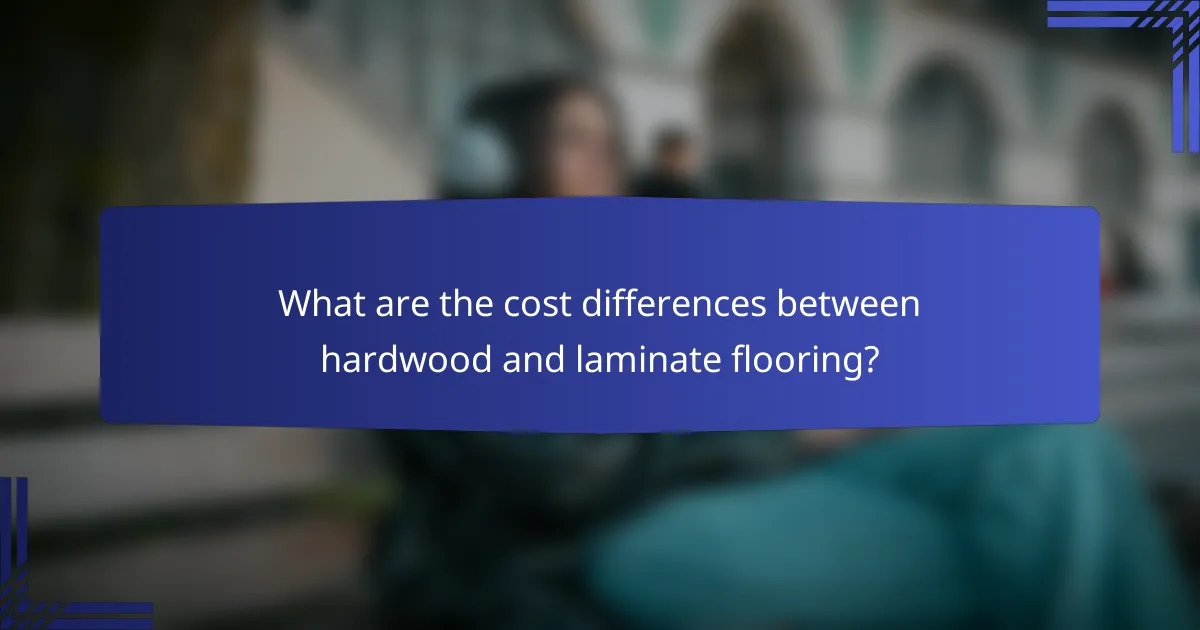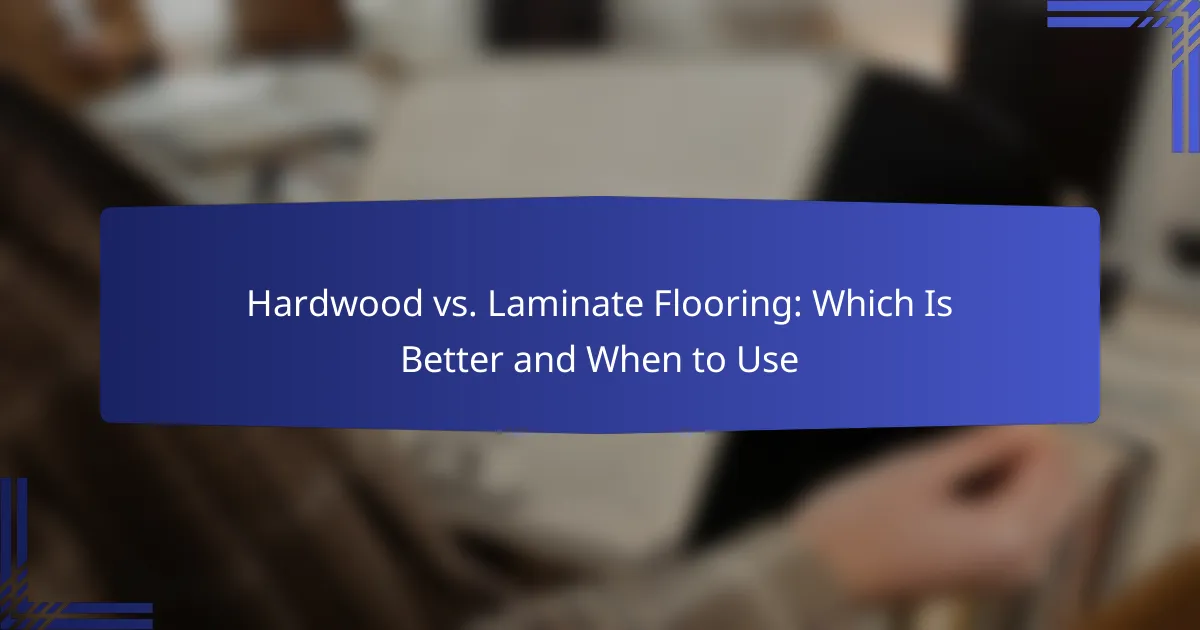When deciding between hardwood and laminate flooring, it’s essential to consider factors like durability, cost, and the specific environment of your home. Hardwood offers a timeless aesthetic and can last for decades with proper care, making it ideal for low-moisture areas. In contrast, laminate provides a budget-friendly alternative that mimics wood but typically lasts only 10 to 20 years, making it suitable for high-traffic areas or temporary solutions.

Which flooring option is more durable in the United States?
In the United States, hardwood flooring generally offers greater durability than laminate flooring, but the choice depends on the specific environment and usage. Hardwood can last for decades with proper care, while laminate typically withstands wear for around 10 to 20 years.
Hardwood flooring durability
Hardwood flooring is renowned for its resilience and longevity. With proper maintenance, it can last 30 years or more, making it a long-term investment. Factors such as wood type, finish, and climate can influence its durability.
Hardwoods like oak and maple are particularly strong, while softer woods may dent or scratch more easily. Regular refinishing can help maintain its appearance and extend its life, but this requires time and expense.
Laminate flooring durability
Laminate flooring is designed to be scratch-resistant and durable, often lasting between 10 to 20 years. Its layered construction includes a protective top layer that helps it withstand daily wear and tear. However, it is less resistant to moisture compared to hardwood.
While laminate can mimic the look of wood, it may not handle heavy impacts as well as solid wood. It’s best suited for areas with moderate foot traffic, such as bedrooms or living rooms, rather than high-traffic zones like hallways or kitchens.

What are the cost differences between hardwood and laminate flooring?
The cost differences between hardwood and laminate flooring can be significant, with hardwood generally being more expensive. While hardwood can range from moderate to high prices depending on the type and quality, laminate offers a more budget-friendly alternative that mimics the look of wood.
Hardwood flooring pricing
Hardwood flooring typically costs between $5 to $15 per square foot, depending on the species, quality, and finish. Exotic woods or premium grades can push prices even higher, sometimes exceeding $20 per square foot. Installation costs can add another $3 to $8 per square foot, making it a considerable investment.
When budgeting for hardwood, consider additional expenses such as underlayment, moisture barriers, and potential maintenance costs. Regular refinishing may be necessary to maintain its appearance, which can add to long-term expenses.
Laminate flooring pricing
Laminate flooring is generally more affordable, with prices ranging from $1 to $5 per square foot. This makes it an attractive option for homeowners looking to save on initial costs. Installation is often simpler and can be a DIY project, potentially reducing labor costs significantly.
While laminate is less expensive upfront, it may not have the same longevity as hardwood. It can be susceptible to scratches and moisture damage, which could lead to replacement costs sooner than with hardwood. Always consider the trade-offs between initial savings and long-term durability when choosing laminate.

When should I choose hardwood flooring?
Choose hardwood flooring when you want a durable, timeless option that enhances the aesthetic value of your home. It’s ideal for areas with low moisture and where you desire a classic look, such as living rooms, dining areas, and bedrooms.
Best use cases for hardwood
Hardwood flooring is best suited for residential spaces that experience moderate foot traffic. It’s particularly effective in homes where style and elegance are priorities, making it a popular choice for formal settings and high-end renovations.
Additionally, hardwood is a great option for those planning to stay in their home long-term, as it can withstand wear and tear while maintaining its appeal. Avoid using hardwood in moisture-prone areas like basements or bathrooms, where laminate may be more suitable.
Long-term investment benefits
Investing in hardwood flooring can significantly increase your property’s value, often yielding a return on investment of 70% to 80% when selling. Its durability means that, with proper care, it can last for decades, reducing the need for frequent replacements.
Moreover, hardwood floors can be refinished multiple times, allowing you to refresh their appearance without complete replacement. This longevity and adaptability make hardwood a wise choice for homeowners looking to enhance both their living space and investment potential.

When is laminate flooring the better choice?
Laminate flooring is often the better choice when affordability, ease of installation, and durability are priorities. It works well in high-traffic areas and can mimic the appearance of hardwood at a fraction of the cost.
Best use cases for laminate
Laminate flooring is ideal for busy households, especially where children and pets are present. Its resistance to scratches and stains makes it suitable for living rooms, hallways, and kitchens.
Additionally, laminate is a good option for rental properties due to its cost-effectiveness and ease of replacement. It can be installed over existing flooring, reducing labor costs and installation time.
Cost-effective benefits
One of the main advantages of laminate flooring is its lower price point compared to hardwood, typically ranging from $1 to $5 per square foot. This makes it accessible for budget-conscious homeowners.
Moreover, laminate requires less maintenance than hardwood, as it does not need refinishing or special cleaning products. This can lead to long-term savings in both time and money.

How do maintenance requirements compare?
Hardwood and laminate flooring have distinct maintenance needs that can affect their longevity and appearance. Generally, hardwood requires more care and attention, while laminate is designed for easier upkeep.
Hardwood maintenance needs
Hardwood flooring requires regular cleaning to prevent dirt and debris buildup. Sweeping or vacuuming weekly, along with occasional mopping using a damp cloth or a wood floor cleaner, is essential to maintain its finish.
Additionally, hardwood may need refinishing every few years, depending on foot traffic and wear. This process can be costly, often ranging from a few hundred to over a thousand dollars, depending on the area and condition of the floor.
Laminate maintenance needs
Laminate flooring is relatively low-maintenance, requiring simple cleaning methods. Regular sweeping or vacuuming, along with mopping with a damp cloth or laminate-specific cleaner, is usually sufficient to keep it looking good.
Unlike hardwood, laminate does not require refinishing. However, it is important to avoid excessive moisture, as this can cause warping. A quick check for spills and prompt cleaning can help maintain its integrity.

What are the environmental impacts of each flooring type?
Hardwood and laminate flooring each have distinct environmental impacts. Hardwood is often sourced from trees, which can lead to deforestation if not managed sustainably, while laminate is made from composite materials, which may involve less sustainable practices but can utilize recycled content.
Hardwood sustainability
Hardwood flooring can be sustainable if sourced from responsibly managed forests that adhere to certification standards like FSC (Forest Stewardship Council). This ensures that the wood is harvested in a way that maintains biodiversity and ecosystem health.
However, the environmental impact varies significantly based on the species and origin of the wood. Local hardwoods may have a lower carbon footprint compared to imported varieties. Consider using reclaimed wood to further reduce environmental impact.
Laminate sustainability
Laminate flooring is generally considered less sustainable than hardwood due to its reliance on synthetic materials and adhesives, which can emit volatile organic compounds (VOCs). However, many manufacturers are now producing laminate with lower VOC emissions and using recycled materials.
When choosing laminate, look for products certified by organizations like GREENGUARD, which indicates lower chemical emissions. Additionally, laminate can be a more affordable option, making it a practical choice for budget-conscious renovations while still being mindful of environmental factors.

How do aesthetics differ between hardwood and laminate?
Hardwood flooring offers a natural, timeless beauty that can enhance the value of a home, while laminate flooring provides a more affordable, versatile alternative with a wide range of designs. The choice between the two often depends on personal style preferences and the intended use of the space.
Visual Appeal
Hardwood flooring is known for its rich textures and unique grain patterns, which can add warmth and character to any room. Each plank is distinct, showcasing the natural variations in wood. In contrast, laminate flooring can mimic the look of hardwood but often lacks the depth and authenticity of real wood.
Color and Finish Options
Hardwood comes in various species, colors, and finishes, allowing homeowners to select a style that complements their decor. Popular finishes include matte, satin, and glossy, each offering a different aesthetic. Laminate, while available in many colors and styles, generally has a more uniform appearance, which may not appeal to those seeking a more natural look.
Durability and Maintenance
Hardwood flooring is durable but can be susceptible to scratches and water damage, requiring regular maintenance like refinishing. Laminate, on the other hand, is designed to be more resistant to wear and tear, making it easier to clean and maintain. However, it may not withstand moisture as well as hardwood, which is an important consideration for areas like kitchens and bathrooms.
